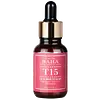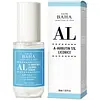What's inside
What's inside
 Key Ingredients
Key Ingredients

 Benefits
Benefits

 Concerns
Concerns

 Ingredients Side-by-side
Ingredients Side-by-side

Water
Skin ConditioningTranexamic Acid
AstringentPropanediol
Solvent1,2-Hexanediol
Skin ConditioningCitric Acid
BufferingPanthenol
Skin ConditioningGlutathione
Allantoin
Skin ConditioningSodium Hyaluronate
HumectantHydrolyzed Hyaluronic Acid
HumectantPolysorbate 20
EmulsifyingCamellia Sinensis Leaf Extract
AntimicrobialSambucus Nigra Flower Extract
RefreshingMomordica Charantia Fruit Extract
Skin ConditioningLeontopodium Alpinum Extract
Skin ConditioningWater
Skin ConditioningButylene Glycol
HumectantAlpha-Arbutin
AntioxidantGlycerin
HumectantIsononyl Isononanoate
Emollient1,2-Hexanediol
Skin ConditioningAloe Barbadensis Leaf Extract
EmollientPanthenol
Skin ConditioningAllantoin
Skin ConditioningDipotassium Glycyrrhizate
HumectantSodium Hyaluronate
HumectantCentella Asiatica Extract
CleansingCamellia Sinensis Leaf Extract
AntimicrobialRosa Rugosa Flower Extract
Skin ConditioningCucumis Melo Fruit Extract
Skin ConditioningLoess Extract
Skin ConditioningGlycyrrhiza Glabra Root Extract
BleachingMadecassoside
AntioxidantAsiaticoside
AntioxidantMadecassic Acid
Skin ConditioningAsiatic Acid
Skin ConditioningCeramide NP
Skin ConditioningBisabolol
MaskingCetearyl Olivate
Sorbitan Olivate
EmulsifyingCetearyl Alcohol
EmollientCaprylic/Capric Triglyceride
MaskingCaprylyl Glycol
EmollientTropolone
Skin ConditioningDimethicone
EmollientCarbomer
Emulsion StabilisingTromethamine
BufferingWater, Butylene Glycol, Alpha-Arbutin, Glycerin, Isononyl Isononanoate, 1,2-Hexanediol, Aloe Barbadensis Leaf Extract, Panthenol, Allantoin, Dipotassium Glycyrrhizate, Sodium Hyaluronate, Centella Asiatica Extract, Camellia Sinensis Leaf Extract, Rosa Rugosa Flower Extract, Cucumis Melo Fruit Extract, Loess Extract, Glycyrrhiza Glabra Root Extract, Madecassoside, Asiaticoside, Madecassic Acid, Asiatic Acid, Ceramide NP, Bisabolol, Cetearyl Olivate, Sorbitan Olivate, Cetearyl Alcohol, Caprylic/Capric Triglyceride, Caprylyl Glycol, Tropolone, Dimethicone, Carbomer, Tromethamine
Ingredients Explained
These ingredients are found in both products.
Ingredients higher up in an ingredient list are typically present in a larger amount.
1,2-Hexanediol is a synthetic liquid and another multi-functional powerhouse.
It is a:
- Humectant, drawing moisture into the skin
- Emollient, helping to soften skin
- Solvent, dispersing and stabilizing formulas
- Preservative booster, enhancing the antimicrobial activity of other preservatives
Allantoin is a soothing ingredient known for its protective and moisturizingg properties. Because of this, it is often added to products with strong active ingredients.
Studies show higher concentrations of this ingredient can promote wound healing.
Though it can be derived from the comfrey plant, allantoin is produced synthetically for cosmetic products to ensure purity.
Learn more about AllantoinCamellia Sinensis Leaf Extract is derived from the leaves of the tea plant. Black tea, green tea, and oolong tea are all harvested from this plant.
This ingredient has many skin benefits:
This ingredient contains polyphenols, a strong antioxidant. Antioxidants help fight off molecules that damage skin cells.
On top of that, the antioxidants in green tea neutralize free-radicals from the sun. This gives the skin some extra UV protection, but should not replace sunscreen.
Many components of tea have anti-inflammatory properties.
Polyphenols and L-theanine help soothe the skin and reduce irritation. The caffeine in Camellia Sinensis Leaf Extract helps calm inflamed blood vessels.
Other compounds found in tea include: Vitamin Bs, linoleic acid, magnesium, calcium, iron, and zinc.
Research has shown both drinking Camellia Sinensis Leaf Tea and applying it to the skin can help boost skin elasticity and hydration. Studies also show using tea extract may reduce sebum, or oil, production.
Learn more about Camellia Sinensis Leaf ExtractPanthenol is a common ingredient that helps hydrate and soothe the skin. It is found naturally in our skin and hair.
There are two forms of panthenol: D and L.
D-panthenol is also known as dexpanthenol. Most cosmetics use dexpanthenol or a mixture of D and L-panthenol.
Panthenol is famous due to its ability to go deeper into the skin's layers. Using this ingredient has numerous pros (and no cons):
Like hyaluronic acid, panthenol is a humectant. Humectants are able to bind and hold large amounts of water to keep skin hydrated.
This ingredient works well for wound healing. It works by increasing tissue in the wound and helps close open wounds.
Once oxidized, panthenol converts to pantothenic acid. Panthothenic acid is found in all living cells.
This ingredient is also referred to as pro-vitamin B5.
Learn more about PanthenolSodium Hyaluronate is hyaluronic acid's salt form. It is commonly derived from the sodium salt of hyaluronic acid.
Like hyaluronic acid, it is great at holding water and acts as a humectant. This makes it a great skin hydrating ingredient.
Sodium Hyaluronate is naturally occurring in our bodies and is mostly found in eye fluid and joints.
These are some other common types of Hyaluronic Acid:
Learn more about Sodium HyaluronateWater. It's the most common cosmetic ingredient of all. You'll usually see it at the top of ingredient lists, meaning that it makes up the largest part of the product.
So why is it so popular? Water most often acts as a solvent - this means that it helps dissolve other ingredients into the formulation.
You'll also recognize water as that liquid we all need to stay alive. If you see this, drink a glass of water. Stay hydrated!
Learn more about Water